Pump Handbook by Igor J. Karassik, Joseph P. Messina, Paul Cooper, Charles C. Heald - 3rd edition
Подождите немного. Документ загружается.

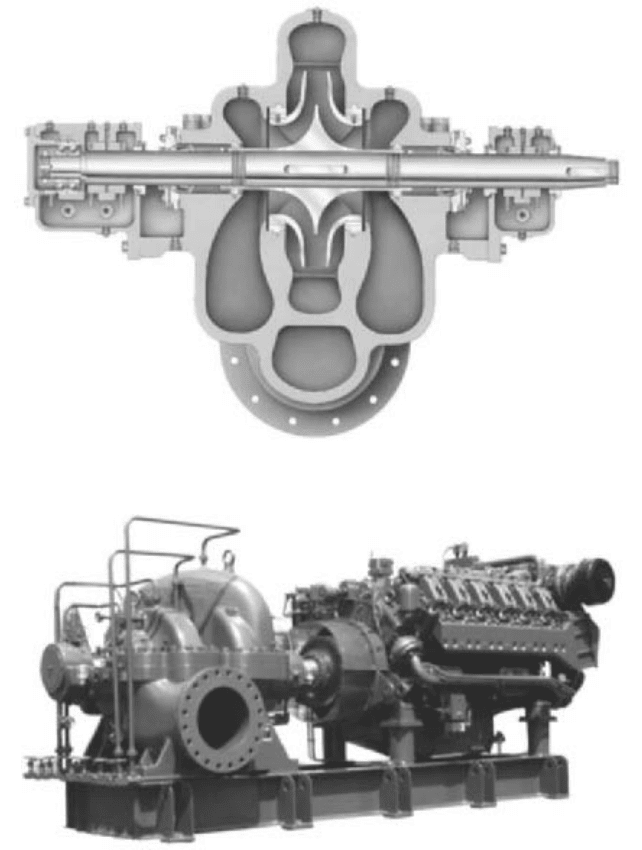
9.7 PETROLEUM INDUSTRY 9.145
FIGURE 9 Single-stage double suction, axially split pump (Flowserve Corporation)
FIGURE 10 Two-stage, double suction pump with engine drive (Flowserve Corporation)
unit (Figure 9) is typical of those used in series operation on large diameter pipelines with
capacities as high as two million barrels per day. One pipeline alone has installed more
than one hundred 5000 hp (3730 kW) pumps of this construction. The two-stage double-
suction pump (a smaller unit is shown in Figure 10 with an engine driver) is typical for
higher head applications, and sizes are available for power ratings to 20,000 hp (15,000
kW). For lateral and smaller diameter pipeline pumping stations, multistage units (Fig-
ure 11) are used. The number of stages chosen corresponds to the differential head
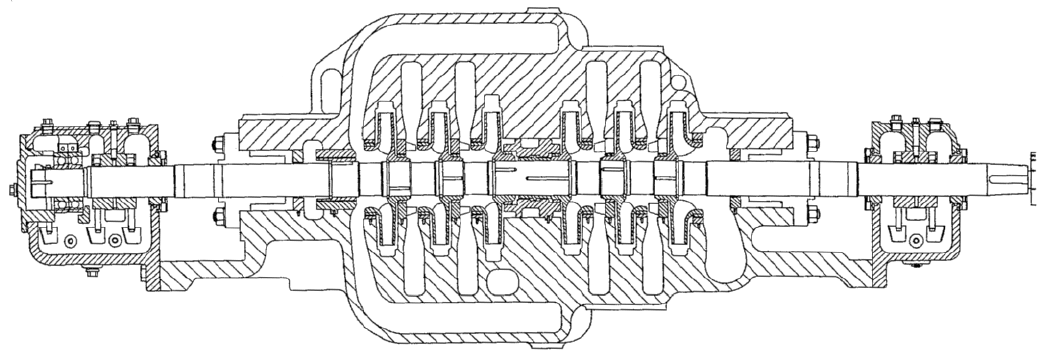
9.146
FIGURE 11 Single-suction, double-volute, axially split, six-stage pipeline pump (Flowserve Corporation)
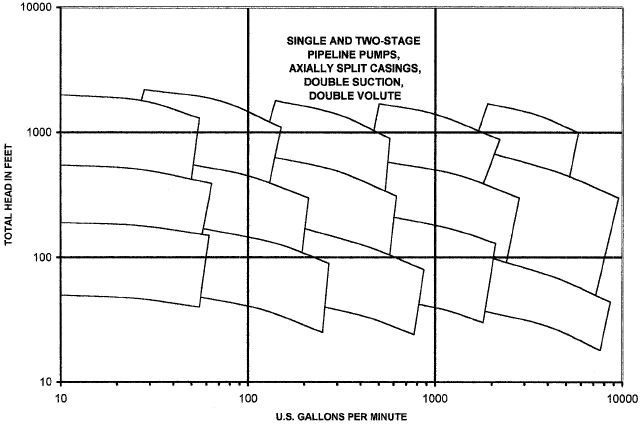
9.7 PETROLEUM INDUSTRY 9.147
required. Multistage units may be destaged initially to produce lower heads, with a sub-
sequent power saving, or the nozzling may be arranged for series or parallel operation of
a portion of the stages.The exact arrangement depends on the system characteristics and
initial and ultimate capacities to be pumped.
All units are equipped with sleeve radial bearings and either ball or hydrodynamic
thrust bearings, as dictated by power (size) and rotating speed. The single- and two-stage
double suction pumps are inherently balanced axially. The multistage units utilize
opposed impeller design to obtain axial balance. All modern units are equipped with
mechanical seals in the seal chamber. Because most pipeline stations are now designed for
unattended outdoor service, a number of safeguard controls are used. These include warn-
ings for low suction pressure, high discharge pressure, high bearing or case temperature
vibration, and excessive seal leakage. Tank farms utilize single- and double-suction inline
vertical pumps or, if the tank is to be pumped dry, vertical canned pumps.
Performance Figure 12 indicates the typical available range for single- and two-stage
pipeline pumps, and Figure 13 shows the range for multistage units. Pipeline units are
custom designed, and the range is constantly being extended. Electric motors are normally
used as drivers. With the utilization of gas turbines, the maximum power employed has
increased dramatically in the last 30 years. Another use of gas turbines on existing
pipelines is for peak capacity booster station service, in which case pumps are direct-
driven at operating speeds as high as 6000 rpm.
Materials Pump part materials commonly specified for crude and product pipeline ser-
vices are shown in Table 2 under columns S-1 through S-9. For the more aggressive ser-
vices and liquids, the higher numbered material columns are preferred.All these material
columns utilize carbon steel pump casings; the impellers, wear rings, and shaft materials
are changed as the material grades increase in alloy and hardness (wear rings) with
advancing material column grade number.
FIGURE 12 Performance coverage for single- and two-stage pipeline pumps
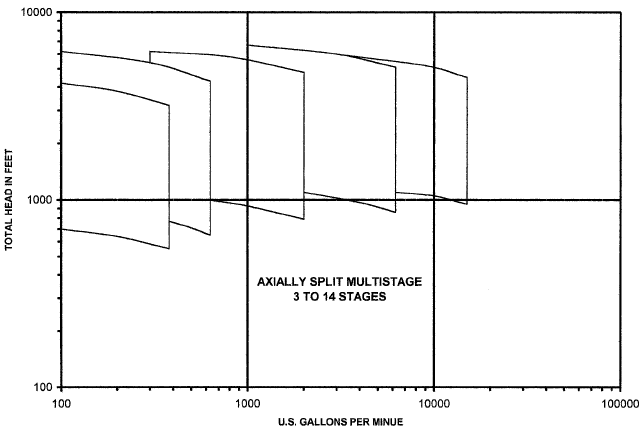
9.148 CHAPTER NINE
FIGURE 13 Performance coverage for multistage, axially split pumps
Pumping Stations The typical piping of a main line pump station in which the units
are arranged in series is shown in Figure 14. As pipeline capacities have increased, one
of the major problems has been the pressure loss at each station. For the station shown,
three discharge valves (one 16 in (406 mm) ball valve manifolded in parallel with two 24
in (610 mm) control valves) were used. This arrangement limited the calculated pressure
drop to that of a length of 36 in (914mm) pipe equal to the distance across the manifold
and still allowed the use of control valves of proven size. When line conditions require
throttling, the 16 in (406 mm) ball valve is first completely closed. If additional throttling
is needed, the two 24 in (610 mm) control valves are closed to produce the required pres-
sure drop. In order to move scrapers or batch separators through each station without
interrupting flow through the pumps, signals (PIG SIG), hydraulically operated 24 in (610
mm) valves, and sequence control wiring are used. The distance between PIG SIG 1 and
PIG SIG 2 represents the volume of station loop to be displaced. The tripping of PIG SIG
3 and PIG SIG 4 controls the valve opening and closing required to divert flow from the
station discharge piping to behind the scraper or batch separator, thus forcing it to leave
the station in the same relative position as it entered. Elbows at pump suction are
arranged to avoid uneven flow distribution in the inlet of the double suction impeller.
Pipeline pumps are tested in accordance with Hydraulic Institute Standards. Reduced
speed tests may be required because of the power limitations of manufacturing plants and
available drivers, and such tests have proven to be extremely accurate indicators of full
speed performance.
SPECIAL SERVICES __________________________________________________
Waterflood
Centrifugal pumps are also used for water injection service when the capac-
ity required is greater than 10,000 barrels per day. Injection pressures requirements vary
considerably from initial startup with operating time. For high-pressure services, usually
above 2500 lb/in
2
(17Mpa), barrel-type pumps are used.
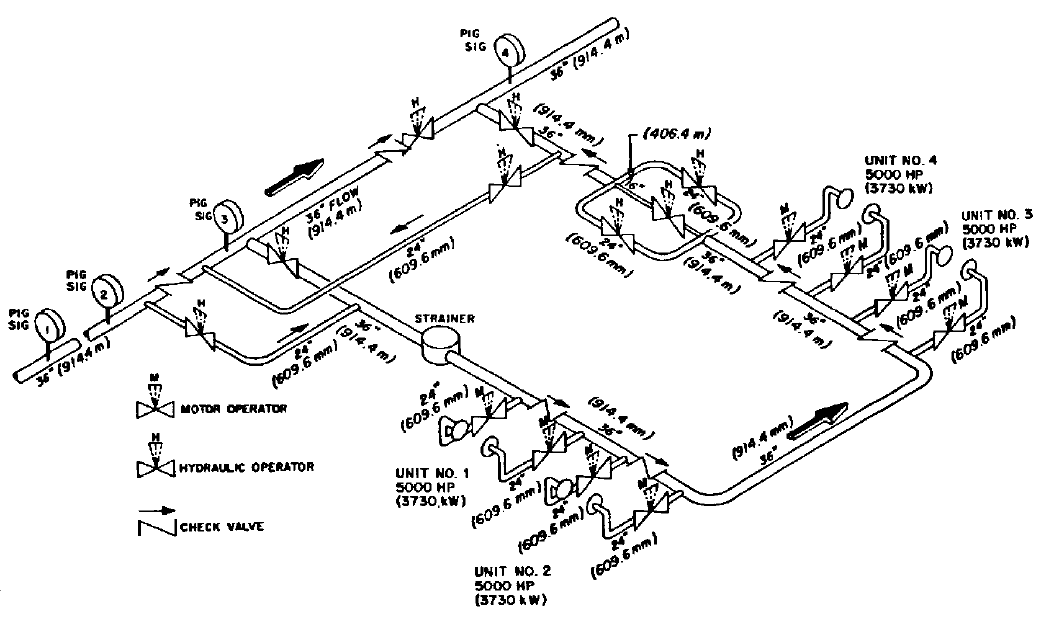
9.149
FIGURE 14 Main line pumping station piping layout

9.150 CHAPTER NINE
Barrel-type pumps (Figure 15), operating in series to speeds in excess of 6000 rpm
using gears and gas turbine or engine drivers, are capable of injection pressures in excess
of 8000 lb/in
2
(55 MPa) gauge. The barrel construction is typically of forged steel with an
austenitic stainless steel welded overlay applied in areas of high velocity. Barrel-type cas-
ings are hydrostatically tested to 12,000 lb/in
2
(83 MPa) gauge and beyond (usually 1
times barrel design pressure).
Most waterflood injection pressure requirements, however, are such that axially split
multistage pumps of the design shown in Figure 4 may be used. As many as 14 stages in
one pump are often utilized to obtain the required differential head. In addition, if still
greater pressures are required, the units may be piped in series.Axially split pumps have
been hydrostatically tested to 6000 lb/in
2
(41 MPa) for a working pressure of 4000 lb/in
2
(27.5 MPa).
For applications where injection liquid is highly corrosive, materials of construction
may include austenitic and duplex stainless steels. Commonly used materials for major
pump components in waterflood applications are shown in Table 2 under material columns
A-8 and D-1. Seal chambers for high pressure and high-speed services may contain a lim-
ited leakage breakdown bushing preceding a mechanical seal for increased reliability.
Reactor Feed Pumps One of the most difficult services encountered in the petroleum
industry is the high-temperature, high pressure reactor feed, or charge pump. Type BB5
pumps, such as the one shown in Figure 5, are most commonly used for these services.
Reactor feed pumps can be subject to operating temperatures in excess of 800°F (425°C)
with discharge pressures in excess of 2500 lb/in
2
(17 MPa) gauge. To produce such high
pressures requires either a large number of stages or high speed. Historically, refiners
have preferred 3600 rpm (3000 rpm in 50 Hz areas) pumps with large numbers of stages.
However, the trend more recently is for shorter, more robust pumps, with fewer stages
operating at higher speeds.
The high temperatures and corrosiveness of the pumped fluids often require the use of
a number of dissimilar metals. Compensation must be made for the different rates of
expansion of the various components at operating temperatures. This presents a critical
design problem for the manufacturer and a significant operability issue for the refinery.
Extreme care is required in the startup and operation of these units. Even so, it is common
for refiners to buy only a single pump for such services (no spare), and for these pumps to
run continuously for five or more years without maintenance.
LPG Pumps Multistage axially split centrifugal pumps have been installed in pipelines
transporting liquefied petroleum gases (LPG) with specific gravities as low as 0.35. The
low lubricity of the pumped fluid required careful selection of wearing part materials. Seal
chambers may utilize single or double (dual) mechanical seals, depending upon local envi-
ronmental issues. At ambient temperatures, the suction pressures can be 1000 lb/in
2
(69
MPa) gauge or more.These fluids may also experience a large temperature rise as a result
of compression that occurs during the pumping process.
Many additional special designs could be mentioned. The wide range of operating con-
ditions and products in the petroleum industry frequently requires pumps specifically
engineered for a certain service.The pump designer is continually challenged to provide a
safe, reliable, and economical design.
PUMPING OF VISCOUS LIQUID _________________________________________
Viscosity of the pumped liquid is a very important factor that must be considered to prop-
erly select and size pumps in many petroleum industry applications. A thorough under-
standing of the relationship between liquid viscosity and pump performance is essential
to proper sizing of both the pump and its driver.
1
2
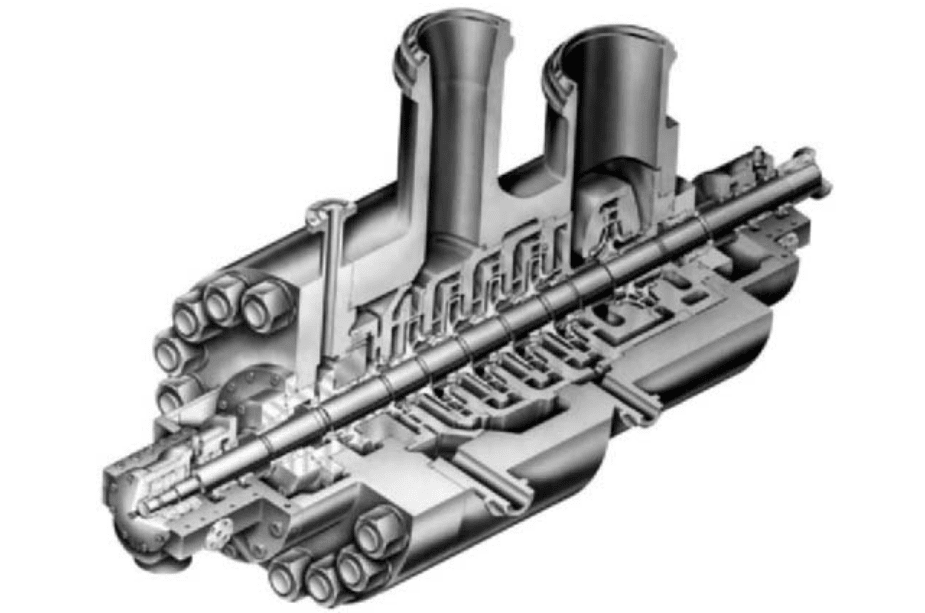
9.151
FIGURE 15 Double-casing multistage barrel-type pump with radially split inner casing (Flowserve Corporation)

9.152 CHAPTER NINE
TABLE 3 Effect of viscosity on performance of a typical centrifugal pump operating
at best efficiency point
Viscosity Capacity Total head Efficiency Brake power
SSU (cSt) gpm (m
3
/h) ft (m) % bhp (kW)
a
Nil 3000 (681) 300 (91) 85 241 (180)
,500 (110) 3000 (681) 291 (89) 71 279 (208)
2,000 (440) 2900 (658) 279 (85) 59 312 (233)
5,000 (1100) 2670 (606) 264 (80) 43 373 (278)
10,000 (2200) 2340 (531) 243 (74) 31 417 (311)
15,000 (3300) 2100 (477) 228 (69) 23 473 (353)
a
All values of brake power based on liquid having a specific gravity of 0.90.
Centrifugal pumps are routinely applied on services with liquids having viscosities below
3000 Saybolt Seconds Universal (SSU) or 660 centistokes (cSt), and may be used up to at
least 15,000 SSU (3300 cSt). (For background information on viscosity, refer to Section 8.1.)
Centrifugal pumps are sensitive, however, to changes in viscosity and will exhibit significant
reductions in capacity and head and rather drastic reductions in efficiency at moderate to
high values of viscosity. The extent of these effects may be seen in Table 3, constructed with
the aid of Figure 16, which provides a convenient means of determining the viscous perfor-
mance of a centrifugal pump when its cold water performance is known. To use Figure 16,
enter at the bottom with the pump capacity, and then proceed vertically upward to the total
head (head per stage for multistage pumps), proceed horizontally right or left to the viscos-
ity value, and finally proceed vertically upward again to the curves for correction factors.The
values thus obtained for the respective correction factors are multiplied by the water per-
formance values for capacity, total head, and efficiency to obtain the equivalent values for
viscous performance. By using the individual correction factors for total head, it is even pos-
sible to approximate the shape of the head-capacity characteristic curve when the viscous
liquid is being pumped, at least to 120% of the best efficiency point flow (Q
N
). The total head
at shutoff will remain essentially constant regardless of liquid viscosity.
Centrifugal pump performance is nearly always specified by the pump manufacturer
basis pumping clean, cold water, even when the pump has been specifically designed for
petroleum industry applications. Cold water is a universal pumping medium. Pumps
selections, however, must necessarily be made to satisfy viscous conditions of service and
require application of these correction factors in the reverse direction. In this case, Figure
16 provides an approximation of equivalent water performance that is probably within the
limits of accuracy of the graph for liquid viscosities in SSU numerically equal to pump
capacity in gallons per minute. (In other words, for a pump with a capacity of 3000 gpm,
Figure 16 is probably quite accurate to viscosities of 3000 SSU.) For higher viscosities, the
initial solution of equivalent water performance, determined in accordance with the fol-
lowing paragraph, may need to be adjusted and then checked by conversion of water per-
formance to viscous performance again.
To determine approximate equivalent water performance when required viscous pump
performance is known, enter Figure 16 at the bottom with the viscous capacity, proceed ver-
tically upward to the desired viscous head (head per stage for multistage pumps), and then
horizontally right or left to the viscosity, and vertically upward to the correction factor
curves for capacity and head. In this case, divide the viscous performance values by the cor-
rection factors to obtain the equivalent water performance values. The pump selection can
then be made, basic ratings established for water, and efficiency can be calculated for the
viscous liquid using the efficiency correction factor applied to the pump efficiency for water.
EXAMPLE To select a pump for 500 gpm (114 m
3
/h) of 3000 SSU (660 cSt) liquid against
a head of 150 ft (46 m), proceed as follows:
From Figure 16, determine C
Q
0.80 and C
H
0.81.
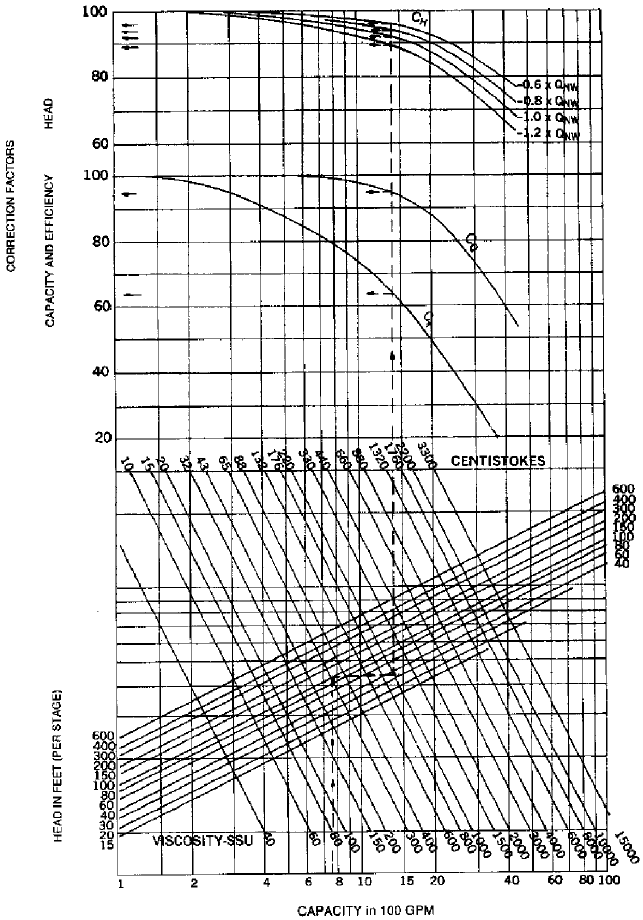
9.7 PETROLEUM INDUSTRY 9.153
FIGURE 16 Performance correction chart for viscous liquids
—
Hydraulic Institute ANSI/HI 2000 Edition Pump
Standards (Reference 3).

9.154 CHAPTER NINE
The water capacity, then, is
In USCS units
In SI units
And the water head is
In USCS units
In SI units
For 625 gpm (142 m
3
/h), 185 ft (57 m), 3000 SSU (660 cSt), Figure 16 indicates C
Q
0.83, C
H
0.85, and C
E
0.42. If the values for C
Q
and C
H
obtained from these calculations
are roughly within 2% of those taken directly from Figure 16, the pump may be selected
on the basis of the water capacity and water head already obtained. Because, in this case,
these values differ from the first approximation by more than 3%, the water performance
should be adjusted as follows:
Adjust the water capacity:
Adjust the water head:
Select the pump for 602 gpm (137 m
3
/h) and 178 ft (55 m) and determine water effi-
ciency from the manufacturer’s rating. Assuming the water efficiency in this case is 75%,
the viscous efficiency
For a specific gravity (sp. gr.) of 0.90,
In USCS units
In SI units
The Hydraulic Institute Standards limit the use of Figure 16 to radial flow centrifugal
pumps with open or closed impellers, handling Newtonian liquids within the pump’s nor-
mal operating range and within the capacity limits indicated on the chart. Failure to heed
these limitations may result in misleading expectations of performance with viscous liq-
uids. Tests on vertical turbine-type pumps, for example, which normally have mixed-flow
rather than radial-flow impellers, have shown that, although the viscous efficiency pre-
dicted from this chart is quite accurate, the viscous head and viscous capacity predictions
are substantially above the demonstrable values. In other words, the performance reduc-
tions determined from the chart would not be severe enough for that type of pump. For
centrifugal pumps that do not fall within the limits of applicability of Figure 16, viscous
performance can be accurately established only by testing.
brake kW
m
3
>h m sp. gr.
376.5 efficiency
114 150 0.90
376.5 0.315
40
54
500 150 0.90
3960 0.315
bhp
gpm ft of head sp. gr.
3960 efficiency
E
V
0.75 0.42 0.315, or 31.5%.
H
W
0.81>0.84 178 ft 155 m2
Q
W
0.80>0.83 602 gpm 1137 m
3
>h2
Q
H
46>0.81 57 m
Q
H
150>0.81 185 ft
Q
W
114>0.80 142 m
3
>h
Q
W
500>0.80 625 gpm
